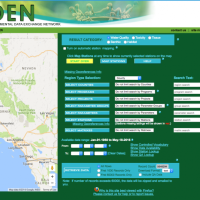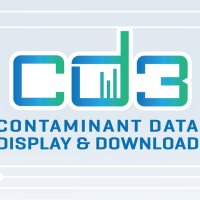Environment Informatics Program
Environmental Informatics Program
Innovative technology driving science solutions
The SFEI Environmental Informatics Program utilizes the latest technology and design concepts to deliver scientific information to a wide range of stakeholders in dynamic, expressive, and cogent ways. Environmental Informatics is organized in 5 focus areas:
Our Program and Focus Areas
Innovative technology driving science solutions
The SFEI Environmental Informatics Program utilizes the latest technology and design concepts to deliver scientific information to a wide range of stakeholders in dynamic, expressive, and cogent ways. Web-based tools, such as EcoAtlas, California Rapid Assessment Method, and Contaminant Data Display and Download, form a lynchpin of SFEI’s success as a communicator of timely and salient scientific information.
- Our Geographic Information Systems team rigorously describes and analyzes the world as it is, as it once was, and as it could be.
- Our Data Services team, forming the core of SFEI’s Regional Data Center, offers a suite of analytical services for the Bay RMP, the California Environmental Data Exchange Network, and various local agencies and programs.
- Using innovative data visualizations, our Application Development team produces tools that integrate disparate data sources to serve the needs of decision-makers and the public.
- Our Design and Communications team provides the bridge between science and its intended audience through creative and thoughtful methods.
- Our Systems team ensures the Institute’s computing infrastructure is robust, secure, and accessible to meet the growing requirements of our databases, websites, and tools.
The Environmental Informatics Program is unique among the programs and departments at SFEI, in that it has a dual role. The first role is to provide the basic computing infrastructure and technical support necessary for any functioning organization; the second is to seek opportunities to apply information technology to promote informed stewardship of the Estuary, both for SFEI and for groups outside the Institute.
Goals
- Continue to increase SFEI’s stature as the place to go for Bay region environmental data, evidenced by:
- Growth in traffic to all SFEI websites
- Growth in the number of websites SFEI hosts
- Growth in the number of external requests for information
- Increase the number of funded projects to manage and/or host Bay environmental data
- Continue to break ground on providing clear, understandable, relevant information products to a variety of audiences
- Maintain a high level of staff satisfaction with internal computing infrastructure and technical support
SFEI’s Environmental Informatics team, working in collaboration with its scientists, explores the frontiers of geodesign and alternative future planning, and facilitates discovery to inform decision-making at all levels of natural resource management.
For additional information, please contact Program Director Tony Hale or Program Manager Cristina Grosso.
Geographic Information Services, or GIS, is a powerful dynamic tool that allows complex analyses to be applied to the landscape. SFEI uses this technology to create practical tools that support better decision-making and promote smart solutions for environmental problems.
SFEI’s GIS focus area supports the Institute’s mission through data production, mapping expertise, spatial analysis, and application development. The department serves three major functions:
- Improve, maintain, and act as a repository for local environmental data sets
- Provide cartographic services to convey complex conditions and present science based solutions to diverse stakeholders
- Leverage the latest technology to develop custom GIS tools and applications to address and analyze environmental problems
Overview of Wetland Remote Sensing Technologies
SFEI has invested in novel, cost-effective solutions to costly problems by capitalizing on recent advances in remote sensing and GIS technology, such as the use of drones (Unoccupied Aerial Systems), machine learning, and other automated mapping methodologies to address environmental challenges.

We encourage you to review the above presentation, showing some of the work that our GIS team performs in the service of wetland resource management.
The Data Services (DS) team offers a suite of analytical services for the Bay RMP, the California Environmental Data Exchange Network (CEDEN), and various agencies and programs serving local and regional interests.
SFEI is the Regional Data Center (RDC) for the San Francisco Bay-Delta and northern montane regions. The Institute manages water quality, tissue, wetlands, historical, and spatial data, and develops tools for uploading, accessing, and visualizing data.
The DS team specializes in managing data associated with a variety of environmental sample types and standardizing results using consistent data vocabulary and business rules. SFEI’s Quality Assurance Officer and associated DS staff thoroughly review environmental results for accuracy, precision, sensitivity, contamination, and completeness.
Over 4 million environmental data records are maintained by the DS team in SFEI’s RDC database. Data approved for public release are disseminated through SFEI’s Contaminant Data Display and Download tool (CD3).
Learn more about our services, and please contact us if you would like help making your data publicly available.
 The Software Engineering focus area provides broad support wherever code-based solutions are needed for SFEI’s projects. In addition to supporting other SFEI Programs’ efforts, we build unique tools in service of other organizations. These tools synthesise, analyze, and visualize data created by SFEI and other scientific organizations. The resulting information products inform decision-making regarding our natural resources found across the State of California.
The Software Engineering focus area provides broad support wherever code-based solutions are needed for SFEI’s projects. In addition to supporting other SFEI Programs’ efforts, we build unique tools in service of other organizations. These tools synthesise, analyze, and visualize data created by SFEI and other scientific organizations. The resulting information products inform decision-making regarding our natural resources found across the State of California.
The Software Engineering team accordingly develops tools that are instrumental to operationalizing the science that SFEI and partners cultivate. The tools form a cornerstone to the success of many projects at SFEI, and the expertise of our software engineers encompasses a range of technical disciplines. Tasks may span from low-level security and efficiency issues, to data modeling and analysis scripts, to the creation of engaging visualizations, maps, and websites. The focus area also provides maintenance for version control tools and consultation for projects that require coding finesse.
Over the years, the Software Engineering team has developed enduring products, ranging from EcoAtlas, an innovative geospatial tool, with a 20-year history, to GreenPlan-IT, a toolset designed to address new and emerging concerns related to urban greening. Whatever the specific project, product, and goals, the Software Engineering focus area values efficiency, modularity, reusability, and legibility and are always excited to engage with new technologies, solutions, and collaborations.

The Institute's Design and Communications team exercises tasks vital to effective public information distribution. The team ensures that the key messages developed through the course of the Institute's scientific reports and technological innovations reach the target audience in the most credible and effective way.
To achieve this primary goal, our designers work closely with both external stakeholders and internal scientists and technologists to maximize impact for new tools, solve communications problems in project outputs, and lend a distinctive style to reports.
Over the years, this talented team has come to define the look and feel of SFEI's most notable output. EcoAtlas, a tool for visualizing aquatic resources, has benefited from the work of the Design and Communications team. Furthermore, the Pulse, RMP's flagship publication, offers a visually compelling view on the Bay's status as the state's most critical estuary. The team enjoys a reputation for excellence among science communicators and looks forward to working with you on your next project.
SFEI's Information Technology Systems team forms the backbone of the technology productivity at the Institute. We support and maintain a wide breadth of hardware and software platforms to ensure staff have the tools they need to perform their work efficiently. Across both local and cloud-hosted servers, we host websites, tools and high performance computing systems to drive a multitude of scientific research objectives and products. The IT Systems team delivers regular training and communications to keep staff apprised about important changes to the technology on which they rely. We conduct full cycle change management processes from needs assessment to go-live implementation to ensure successful adoption of new systems. Through careful planning and coordination and, when necessary, deft troubleshooting, we keep a complex network operating smoothly and facilitate continuous innovation through adaptation and renewal.
Website Hosting and Management

SFEI continues to expand website hosting and management services, both for SFEI projects and for external partners. Notable sites include:
- sfei.org — Main SFEI site
- ecoatlas.org — EcoAtlas, a tool for visualizing the condition and extent of California's aquatic resources
- cd3.sfei.org — CD3, a tool for visualizing and downloading water quality data in the SFEI data center
- enviz.org — Environmental Visualization, a dynamic time-series visualization tool
- cramwetlands.org — CRAM wetland assessments
- sfestuary.org — San Francisco Estuary Project site (partner site)
- wrmp.org — Wetlands Regional Monitoring Program
- southbayrestoration.org — South Bay Salt Ponds restoration (partner site)
Infrastructure
SFEI has assembled an array of hardware and software infrastructure to serve multiple needs. The resources include 16 physical servers; various database technologies; numerous web servers, application frameworks and libraries; GIS software including ArcGIS and ArcSDE; Web GIS technologies, including ArcGIS Server, GeoServer, Mapserver, Openlayers, Google Maps API; Offsite backup; Self-starting diesel backup generator to protect all servers and desktops; server colocation and cloud-based hosting options.
Our Team in the Environment Informatics Program
The San Francisco Estuary Institute comprises over sixty scientists, technologists, and designers who offer a wide range of expertise. Each team member, in her or his own way, helps to define environmental problems, advance public debate about them through sound science, and support consensus-based solutions that improve environmental planning, management, and policy development.
Projects Related to the Environment Informatics Program
 The Pulse of the Bay
The Pulse of the Bay
https://www.sfei.org/documents/2019-pulse-bay-pollutant-pathwaysDownload the Pulse of the Bay! This report from the Regional Monitoring Program for Water Quality in San Francisco Bay features articles on the four major pathways by which pollutants enter the Bay: municipal wastewater, industrial wastewater, stormwater, and dredging and dredged sediment disposal. Each article provides a basic introduction to the pathway and discusses the regulatory framework, recent findings, and future challenges. The report also includes some of the latest highlights from monitoring of important parameters such as nutrients, emerging contaminants, mercury, PCBs, and selenium.
 California Aquatic Resource Inventory (CARI)
California Aquatic Resource Inventory (CARI)
The California Aquatic Resources Inventory (CARI) is a Geographic Information System (GIS) based map of wetlands, streams, and riparian areas within California that is hosted online through EcoAtlas.
 Statewide Plastics Monitoring Plan & Strategy
Statewide Plastics Monitoring Plan & Strategy
Plastics, in their various chemical composition and sizes, pose serious challenges to the vitality of California's ecosystems. Once escaped into the environment, plastic contamination persists for very long periods and breaks down into ever smaller pieces, becoming more readily available to wildlife and populations who live, work, and play in those same habitats.
 RMP Update
RMP Update
The Regional Monitoring Program for Water Quality in San Francisco Bay is an innovative collaboration of the San Francisco Bay Regional Water Quality Control Board, the regulated discharger community, and the San Francisco Estuary Institute. It provides water quality regulators with the information they need to manage the Bay effectively. The RMP produces two types of summary reports: The Pulse of the Bay and the RMP Update. The Pulse focuses on Bay water quality and summarizes information from all sources.
 Next Generation Urban Greening
Next Generation Urban Greening
SFEI is working with partners across the Bay Area to design tools to help cities achieve biodiversity, stormwater, and climate benefits through multifunctional green infrastructure.
 Re-Oaking
Re-Oaking
“Re-Oaking” is an approach to reintegrating oaks and other native trees within the developed California landscape to provide a range of ecosystem services. The concept has emerged from SFEI's research into the distribution and characteristics of California's former valley oak savannas -- a distinctive, widespread habitat that was mostly lost a century ago. Now valley oaks and other native trees are being recognized for the benefits they did -- and could again – provide, as communities design the ecologically healthy and resilient landscapes of the future.
 California Pesticides: A Data Visualization Tool to Link Pesticide Use and Management to Water Quality
California Pesticides: A Data Visualization Tool to Link Pesticide Use and Management to Water Quality
Despite California's data-rich environment, there are still many obstacles when trying to access and understand pesticide data at the nexus of water quality, ecological effects, and human health. We recognize a need to fill data gaps, not necessarily by collecting new data, but by better leveraging information already technically in the public domain. The goal of this project is to bring pesticide reporting, occurrence, and toxicity data together in ways that yield insights and meet the expressed needs of stakeholders in clear, efficient, credible, and repeatable ways.
 Shallow Groundwater Response to Sea Level Rise
Shallow Groundwater Response to Sea Level Rise
The response of shallow groundwater to sea-level rise is a relatively new field of study. For low-lying coastal communities, sea-level rise adaptation efforts must consider the potential for groundwater rise to avoid maladaptation. The need to better understand this slow and chronic threat was identified as a critical data gap in the San Francisco Bay Area’s adaptation efforts during the Bay Area Groundwater and Sea-Level Rise Workshop in 2019.
 RipZET: A GIS-based Tool for Estimating Riparian Zones
RipZET: A GIS-based Tool for Estimating Riparian Zones
The Riparian Zone Estimator Tool (RipZET) is a decision support tool developed by the San Francisco Estuary Institute and Aquatic Science Center for the California Riparian Habitat Joint Venture and the California Water Resources Control Board to assist in the visualization and characterization of riparian areas in the watershed context.
 Perfluoroalkyl and Polyfluoroalkyl Substances (PFAS)
Perfluoroalkyl and Polyfluoroalkyl Substances (PFAS)
A recent analysis of PFAS in the surface waters of SF Bay was conducted to understand the occurrence, fate, and potential risks to ecological and human health. Eleven of 40 PFAS were detected at part per trillions (ppt) concentrations in ambient water collected in 2021 from 22 sites in the Bay. Seven PFAS (PFPeA, PFHxA, PFHpA, PFOA, PFBS, PFHxS, and PFOS), were found in at least 50% of samples. Concentrations of PFAS in the Bay were generally consistent with similar studies globally for surface water. Sustained, multi-matrix monitoring of this important class of contaminants of emerging concern is a high priority for the RMP.
- 1 of 5
- next ›
Publications related to the Environment Informatics Program
The Institute has collectively produced more than 1300 reports, articles, and other publications over the course of its 24-year existence. The following list represents those publications associated with this individual program and its focus areas.
Nothing found
Year of Publication: 2024
. Baylands Change Basemap: Mapping Progress Toward Habitat Restoration Goals. 2024.  (15.8 MB)
(15.8 MB)
. Factsheet: How to Generate a Watershed Profile in EcoAtlas. 2024.  (1.87 MB)
(1.87 MB)
. Robertson Park and Medeiros Parkway sUAS Surveys for the Sycamore Pilot Implementation Project. Prepared for Zone 7 Water Agency and US Environmental Protection Agency’s Water Quality Improvement Fund. In collaboration with San Francisco Estuary Institute. 2024 .  (27.86 MB)
(27.86 MB)
. WRMP Baylands Habitat Map 2020 Classification Key. . 2024 .  (35.93 MB)
(35.93 MB)
Year of Publication: 2023
. Adding Salinity Modifiers to CARI - Methods Brief. San Francisco Estuary Institute; 2023 .  (1.13 MB)
(1.13 MB)
. Data Management Procedures: For Lake County Water Resources Department (LCWRD) and Habematolel Pomo Of Upper Lake (HPUL) Tribe Water Quality Monitoring Data. 2023 p. 18. Report No.: 1140.  (4.22 MB)
(4.22 MB)
. Landscape Scenario Planning Tool User Guide v2.2.0. Richmond, Calif: San Francisco Estuary Institute; 2023 .  (5.27 MB)
(5.27 MB)
. McCosker Creek Restoration and Public Access Project: Alder Creek Daylighting Additional Monitoring Elements - Final Report. Richmond, CA: San Francisco Estuary Institute; 2023 . Report No.: 1157.  (8.07 MB)
(8.07 MB)
. WRAMP Training and Outreach Plan. 2023 p. 39. Report No.: 1136.  (5.8 MB)
(5.8 MB)
Year of Publication: 2022
. 2022 Pulse of the Bay. Richmond, California: San Francisco Estuary Institute; 2022 . Report No.: 1095.  (5.57 MB)
(5.57 MB) (63.26 MB)
(63.26 MB)
. Building Capacity of the California Wetland Program Plan to Protect and Restore Vernal Pools. Richmond. CA: San Francisco Estuary Institute; 2022 p. 30. Report No.: 1087.  (2.07 MB)
(2.07 MB)
. Landscape Scenario Planning Tool User Guide v2.0. 2022 .  (4.84 MB)
(4.84 MB)
- 1 of 6
- next ›
The Data Services (DS) team offers a suite of analytical services for the Bay RMP, the California Environmental Data Exchange Network (CEDEN), and various agencies and programs serving local and regional interests.
SFEI is the Regional Data Center (RDC) for the San Francisco Bay-Delta and northern montane regions. The Institute manages water quality, tissue, wetlands, historical, and spatial data, and develops tools for uploading, accessing, and visualizing data.
The DS team specializes in managing data associated with a variety of environmental sample types and standardizing results using consistent data vocabulary and business rules. SFEI’s Quality Assurance Officer and associated DS staff thoroughly review environmental results for accuracy, precision, sensitivity, contamination, and completeness.
Over 4 million environmental data records are maintained by the DS team in SFEI’s RDC database. Data approved for public release are disseminated through SFEI’s Contaminant Data Display and Download tool (CD3).
Learn more about our services, and please contact us if you would like help making your data publicly available.
|
|
The Pulse of the Bay | https://www.sfei.org/documents/2019-pulse-bay-pollutant-pathwaysDownload the Pulse of the Bay! This report from the Regional Monitoring Program for Water Quality in... |
|
|
Dredged Material Testing Thresholds for San Francisco Bay Area Sediments | This page presents sediment chemistry thresholds for seven different contaminant classes, used by the Dredged Material Management Office (DMMO) for determining when... |
|
|
RMP Update | The Regional Monitoring Program for Water Quality in San Francisco Bay is an innovative collaboration of the San Francisco Bay Regional Water Quality Control Board, the... |
|
|
Development of Lake County Water Quality Data Exchange Program (Phase 1) | SFEI will leverage its experience as a Regional Data Center for CEDEN to deliver a scientifically sound data management strategy and plan for the Habematolel Pomo |
|
|
Perfluoroalkyl and Polyfluoroalkyl Substances (PFAS) | A recent analysis of PFAS in the surface waters of SF Bay was conducted to understand the occurrence, fate, and potential risks to ecological and human health. Eleven of 40... |
|
|
Bird Egg Monitoring | XX UNDER CONSTRUCTION XX |
|
|
Contaminants in San Francisco Bay Sport Fish | XX UNDER CONSTRUCTION XX |
|
|
Long-term Water, Sediment, and Bivalve Monitoring | Water Chemistry and Toxicity |
|
|
Microplastic Pollution in San Francisco Bay | Plastic pollution is gaining global recognition as a threat to the resilience and productivity of ocean ecosystems. |
|
|
California Environmental Data Exchange Network (CEDEN) | The California Environmental Data Exchange Network (CEDEN) is a central location to find and share information about California’s surface waters, including streams, lakes,... |
|
|
Vernal Pool Habitat Restoration and Protection CRAM Tools for the Central Valley, CA | The California Wetland Program Plan (WPP) seeks to strengthen protection for wetlands in many ways, |
|
|
Microplastic Pollution | The RMP has conducted initial studies of microplastic pollution in San Francisco Bay. |
|
|
Green Infill - Clean Stormwater | SFEI collaborated with the San Francisco Estuary Partnership and San Mateo Countywide Water Pollution Prevention Program to monitor the effectiveness of Low Impact Design... |
|
|
Geospatial Compliance Monitoring System | The Geospatial Compliance Monitoring System (GCMS) is an online database that records all biological opinions and the information associated with them to ensure that... |
|
|
Regional Data Center | SFEI is one of the state's Regional Data Centers that exchanges water quality data to the California Environmental Data Exchange Network (CEDEN). SFEI provides data... |
|
|
Contaminant Data Download and Display (CD3) | Contaminant Data Display and Download Tool or CD3 is an innovative visualization tool for accessing water quality data for the San Francisco Bay-Delta and northern montane |
|
|
Wetlands Regional Monitoring Project | This Prop 50 - funded project was a three-year effort to monitor and track changes in Bay Area wetland condition. This wetland monitoring toolkit meets basic information... |
|
|
Making North Coast 401 Certified Caltrans Projects Available on EcoAtlas | This project enhanced access to watershed assessment data by making 401 certified Caltrans projects and maps, from the North Coast, available online through EcoAtl |
|
|
Small Tributaries Loading Strategy | The Small Tributaries Loading Strategy (STLS) is overseen by the |
|
|
Statewide Bioaccumulation Monitoring | The Surface Water Ambient Monitoring Program (SWAMP) Roundtable has formed a subcommittee, the Bioaccumulation Oversight Group (BOG) that develops plans for and guides... |
|
|
Small Fish Monitoring | Small fish have been analyzed in the RMP Exposure and Effects Pilot Study since 2005. Small fish are excellent indicators of biological uptake of contaminants, particularly... |
|
|
Selenium in Wastewater | SFEI has been asked to characterize selenium in six wastewater treatment effluent. Facilities will be sampled four times in 2011; twice in the wet season and twice in the dry... |
|
|
Visualizing and Sharing Intensive Data Assessments | With California's drought rapidly changing the outlook for natural resources, decision-makers must be equipped with information and tools that facilitate clear and rapid... |
|
|
San Francisco Bay Fish Project | The San Francisco Bay Fish Project is a two-year project to reduce exposure to harmful chemicals from eating San Francisco Bay fish. This Project is part of the Regional... |
|
|
North Bay Mercury Biosentinel Monitoring | In 2011-2014 SFEI and UC Davis developed and implemented a multi-species biosentinel monitoring approach as an effective and efficient way of monitoring methylmercury... |
|
|
McNabney Marsh - Benthos | The McNabney Marsh has not seen tidal waters in about 100 years and due to the perseverance by and diligence of the Peyton Slough Wetlands Advisory Committee (PSWAC) members... |
|
|
Load Monitoring in Representative Watersheds | Overview |
|
|
Lindsey Slough Methylmercury Study | Solano Land Trust is undertaking a project in 2010 at the Calhoun Cut Ecological Reserve (CCER) to remove constructed levees. |
|
|
Klamath Basin Monitoring Program | Over the past decade, the Klamath Basin has been in the forefront of national attention due to contentious resource issues related to water allocation, water quality,... |
|
|
Grassland Bypass Project | This project continues to monitor impacts of the use of a portion of the San Luis Drain for conveyance of agricultural discharge. |
|
|
Fish Mercury Project (FMP) | California Bay-Delta Authority (CBDA) approved a $4.5 million proposal to examine mercury and other chemicals in fish in the Bay-Delta watershed, to increase public awareness... |
|
|
Factors Controlling Suspended Sediment in San Francisco Bay | Since 1993, this element of the RMP focused on monitoring and understanding suspended sediment dynamics in the Estuary through the monitoring of suspended sediments at key... |
|
|
Dioxin Monitoring | San Francisco Bay was placed on the State of California’s 303(d) list of impaired waters in 1998 as a result of elevated concentrations of dioxins and furans (commonly... |
|
|
Contaminants of Emerging Concern Strategy | More than 100,000 chemicals have been registered or approved for commercial use in the US. |
|
|
DEDUCE: Delta Environmental Data for the Understanding of a California Estuary | The purpose of this project is to expand the existing San Francisco Bay Regional Data Center (RDC) to include the Sacramento-San Joaquin Delta and Suisun Marsh (Delta). The... |
|
|
Archive Sample Tool | The Archive Sample Tool provides a web interface that SFEI researchers can use to browse the RMP archives when considering using archive material for a study. |
|
|
Montezuma Data Management | This project provides data management for the Montezuma tidal marsh restoration Project described in the Wetlands Science Program. |
|
|
Clean Watersheds for a Clean Bay | The Clean Watersheds For A Clean Bay project is multi-year project focused on implementing the PCBs and mercury Total Maximum Daily Load (TMDL) water quality restoration... |
|
|
Annual Monitoring Report | The San Francisco Estuary Institute has been collecting water, sediment and tissue samples from the San Francisco Bay and tributaries since 1993. |
Year of Publication: 2023
Year of Publication: 2017
Year of Publication: 2016
Year of Publication: 2015

The Institute's Design and Communications team exercises tasks vital to effective public information distribution. The team ensures that the key messages developed through the course of the Institute's scientific reports and technological innovations reach the target audience in the most credible and effective way.
To achieve this primary goal, our designers work closely with both external stakeholders and internal scientists and technologists to maximize impact for new tools, solve communications problems in project outputs, and lend a distinctive style to reports.
Over the years, this talented team has come to define the look and feel of SFEI's most notable output. EcoAtlas, a tool for visualizing aquatic resources, has benefited from the work of the Design and Communications team. Furthermore, the Pulse, RMP's flagship publication, offers a visually compelling view on the Bay's status as the state's most critical estuary. The team enjoys a reputation for excellence among science communicators and looks forward to working with you on your next project.
|
|
The Pulse of the Bay | https://www.sfei.org/documents/2019-pulse-bay-pollutant-pathwaysDownload the Pulse of the Bay! This report from the Regional Monitoring Program for Water Quality in... |
|
|
Preparing for the Storm | Catalyzed by the extensive damages caused by the Winter 2016-2017 storms and the opportunity to align flood response with major habitat improvement, Preparing for the Storm ... |
|
|
State of the Estuary Report | The State of the Estuary Report evaluates the status and trends of a suite of indicators selected to represent ecosystem health in the San Francisco Bay and Sacramento-San... |
|
|
RMP Update | The Regional Monitoring Program for Water Quality in San Francisco Bay is an innovative collaboration of the San Francisco Bay Regional Water Quality Control Board, the... |
|
|
Re-Oaking | “Re-Oaking” is an approach to reintegrating oaks and other native trees within the developed California landscape to provide a range of ecosystem services. The concept has... |
|
|
Perfluoroalkyl and Polyfluoroalkyl Substances (PFAS) | A recent analysis of PFAS in the surface waters of SF Bay was conducted to understand the occurrence, fate, and potential risks to ecological and human health. Eleven of 40... |
|
|
Microplastic Pollution in San Francisco Bay | Plastic pollution is gaining global recognition as a threat to the resilience and productivity of ocean ecosystems. |
|
|
Microplastic Pollution | The RMP has conducted initial studies of microplastic pollution in San Francisco Bay. |
|
|
Resilient Silicon Valley | Tools for the creation of a resilient Silicon Valley ecosystem. |
|
|
San Francisco Bay Shore Inventory | SFEI is developing an online interactive map to support regional planning and assessment given accelerated sea level rise around the Bay. |
|
|
Resilient By Design: Science Advisors | The challenges of accelerating sea level rise and aging shoreline infrastructure are creating a once-in-a-century opportunity to redesign the Bay shore. |
|
|
San Francisco Bay Shoreline Adaptation Atlas: Working with Nature to Plan for Sea Level Rise | In partnership with SPUR, The Operational Landscape Units project, funded by the |
|
|
Resilience Atlas | The Resilience Atlas is a compilation of cutting-edge science, creative visions and relevant spatial data to support planners, designers, polic |
|
|
Delta Landscapes Project | The Delta Landscapes Project, which began in 2012 and will run through 2016, has developed a body of work to inform landscape-scale restoration of the Sacramento-San Joaquin... |
|
|
BCDC GIS, Graphics, and Technological Services | The San Francisco Estuary Institute is working to provide support for the San Francisco Bay Conservation and Development Commission (BCDC) though Geographical Information... |
|
|
Carlos Street Rain Garden Interpretative Sign | The Carlos Street rain garden in Moss Beach collects and filters stormwater from the street, Post Office parking lot, and adjacent private properties and businesses. By... |
Year of Publication: 2024
Year of Publication: 2022
Year of Publication: 2021
Year of Publication: 2018
Year of Publication: 2017
Year of Publication: 2016
Year of Publication: 2015
Geographic Information Services, or GIS, is a powerful dynamic tool that allows complex analyses to be applied to the landscape. SFEI uses this technology to create practical tools that support better decision-making and promote smart solutions for environmental problems.
SFEI’s GIS focus area supports the Institute’s mission through data production, mapping expertise, spatial analysis, and application development. The department serves three major functions:
- Improve, maintain, and act as a repository for local environmental data sets
- Provide cartographic services to convey complex conditions and present science based solutions to diverse stakeholders
- Leverage the latest technology to develop custom GIS tools and applications to address and analyze environmental problems
Overview of Wetland Remote Sensing Technologies
SFEI has invested in novel, cost-effective solutions to costly problems by capitalizing on recent advances in remote sensing and GIS technology, such as the use of drones (Unoccupied Aerial Systems), machine learning, and other automated mapping methodologies to address environmental challenges.

We encourage you to review the above presentation, showing some of the work that our GIS team performs in the service of wetland resource management.
|
|
California Aquatic Resource Inventory (CARI) | The California Aquatic Resources Inventory (CARI) is a Geographic Information System (GIS) based map of wetlands, streams, and riparian areas within California that is hosted... |
|
|
Preparing for the Storm | Catalyzed by the extensive damages caused by the Winter 2016-2017 storms and the opportunity to align flood response with major habitat improvement, Preparing for the Storm ... |
|
|
California Trash Monitoring Methods Project | The California Ocean Protection Council (OPC), in close partnership with the State Water Board, has recognized the importance of standard methods for trash monitoring and has... |
|
|
Delta Aquatic Resource Inventory | DARI is the Delta Aquatic Resources Inventory of surface waters, wetlands and other aquatic resources in the Sacramento-San Joaquin Delta (Delta). |
|
|
Shallow Groundwater Response to Sea Level Rise | The response of shallow groundwater to sea-level rise is a relatively new field of study. |
|
|
RipZET: A GIS-based Tool for Estimating Riparian Zones | The Riparian Zone Estimator Tool (RipZET) is a decision support tool developed by the San Francisco Estuary Institute and Aquatic Science Center for the California Riparian... |
|
|
Tahoe WRAMP Demonstration: Watershed Assessment | The Tahoe WRAMP Watershed Demonstration Project transferred statewide wetland monitoring and assessment tools to Sierra Nevada environmental agencies and organizations by... |
|
|
Healthy Watersheds Resilient Baylands | Through the EPA-funded Healthy Watersheds Resilient Baylands project, SFEI and sixteen partner organizations are developing multi-benefit tools to enhance climate change... |
|
|
Coastal Wetlands, Beaches and Watersheds Inventory | The Ocean Protection Council (OPC) and SFEI will develop an inventory of the wetlands and other surface waters of all California’s coastal HUC-8 watersh |
|
|
Bay Area Aquatic Resource Inventory (BAARI) | The Bay Area Aquatic Resources Inventory (BAARI) is a GIS base map of the Bay Area's wetlands, open water, streams, ditches, tidal marshes and flats, and riparian areas.... |
|
|
Russian River Regional Monitoring Program: Comprehensive Basemap of Surface Waters and Riparian Areas | This project will build on existing projects funded by the CA State Water Board, Ocean Protection Council, Sonoma Ecology Center, and Sonoma County to produce a basemap of... |
|
|
Vernal Pool Habitat Restoration and Protection CRAM Tools for the Central Valley, CA | The California Wetland Program Plan (WPP) seeks to strengthen protection for wetlands in many ways, |
|
|
Six County Aquatic Resource Inventory | The US Army Corps of Engineers, Sacramento Division updated wetland and stream maps for the 6 county area (Sacramento, Placer, Yolo, El Dorado, Yuba, and Sutter Counties) to... |
|
|
GreenPlan-IT | Green infrastructure (GI), such as permeable pavement, rain gardens, tree-well planters, or bioswales, can be used as cost-effective, resilient approaches to managing... |
|
|
EcoAtlas | EcoAtlas is a set of tools for generating, assembling, storing, visualizing, sharing, and reporting environmental data and information. |
|
|
Russian River Watershed Projects at the San Francisco Estuary Institute | Our projects in the Russian River Watershed help us to understand our past, understand our present, and envision our future. Learn more about what SFEI is doing in... |
|
|
Trees and Hydrology in Urban Landscapes | Effective implementation of urban greening strategies is needed to address legacies of landscape change and environmental degradation, ongoing development pressures, and the... |
|
|
Satellite Imaging to Detect Cyanobacterial Blooms | Satellite remote sensing will aid the State of California in assessing cyanobacterial bloom threats to animal and human health across the state’s numerous large lakes. |
|
|
Development of a Trash Monitoring Method for Tobacco Product Waste | Smoking has long been known to lead to tobacco-related diseases and harmful health outcomes, including heightened risk of cancer, stroke, and heart disease. |
|
|
Coyote Creek Native Ecosystem Enhancement Tool | The Coyote Creek Native Ecosystem Enhancement Tool (CCNEET, neet. ecoatlas.org) is an online decision-support tool to identify opportunities to improve ecological conditions... |
|
|
Resilient Silicon Valley | Tools for the creation of a resilient Silicon Valley ecosystem. |
|
|
Historical Wetlands of the Southern California Coast Phase 2: Historical Extent and Change Over Time | This project builds on earlier efforts to provide comprehensive analysis of the 40 T-sheets that cover the southern California Bight (S |
|
|
U.S. Coast Survey Maps of California (South Coast) | Until the advent of this new map viewer, a valuable resource was largely unavailable to coastal planners. Now, US Coastal Survey maps are free for broad use. |
|
|
Head of Tide | SFEI completed a pilot study focused on creating a framework for a rapid protocol that can be used to delineate the current and future head of tide zone for San Francisco Bay... |
|
|
Bay Area Trash Tracker | This password protected tool allows Bay Area municipalities dealing with trash control issues to research available trash capture devices and add information on maintenance... |
|
|
Mapping Shoreline Change in San Pablo Bay | Using a systematic, empirical, and repeatable approach, we mapped the location of the shorelines in San Pablo Bay at three points in time: 1855, 1993, and 2010. We then... |
|
|
South Bay Salt Pond Restoration Project: GIS & Web Services | The South Bay Salt Pond Restoration Project is the largest tidal wetland restoration project on the West Coast. |
|
|
Visualizing and Sharing Intensive Data Assessments | With California's drought rapidly changing the outlook for natural resources, decision-makers must be equipped with information and tools that facilitate clear and rapid... |
|
|
San Francisco Bay Shore Inventory | SFEI is developing an online interactive map to support regional planning and assessment given accelerated sea level rise around the Bay. |
|
|
Montezuma Technical Review Team | The Montezuma wetland restoration project is returning ~2,000 acres of diked baylands to tidal, seasonal, and managed wetlands in an eastern portion of Suisun Bay near the... |
|
|
Klamath Basin Monitoring Program | Over the past decade, the Klamath Basin has been in the forefront of national attention due to contentious resource issues related to water allocation, water quality,... |
|
|
Adapting to Rising Tides: East Contra Costa Shoreline Flood Explorer | As a continuation of our collaboration with BCDC and the Adapting to Rising Tides (ART) team, the technical team at SFEI has developed a new version of the sea-level rise... |
|
|
Adapting to Rising Tides: Bay Shoreline Flood Explorer | SFEI’s Environmental Informatics team has designed and developed the Bay Area Flood Explorer for the Bay Conservation and Development Commission's (BCDC) Adapting to Rising... |
|
|
BCDC GIS, Graphics, and Technological Services | The San Francisco Estuary Institute is working to provide support for the San Francisco Bay Conservation and Development Commission (BCDC) though Geographical Information... |
|
|
SFEI Unoccupied Aerial Systems | SFEI has developed novel, cost-effective solutions to costly problems. In particular, our work with drones or Unoccupied Aerial Systems (UAS) has yielded very promising... |
|
|
National Hydrography Dataset (NHD) Data Stewardship | As the San Francisco Bay Area Regional Steward for the USGS National Hydrography Dataset, SFEI has been working with National and State USGS NHD representatives to coordinate... |
|
|
Tahoe WRAMP Demonstration: Mapping Standards | The Tahoe WRAMP Demonstration Project implemented detailed and standardized mapping protocols within the Tahoe Basin in two watersheds, based on BAARI mapping standards. New... |
|
|
North Coast WRAMP Demonstration: Mapping Standards | The North Coast WRAMP Demonstation Project focused on mapping and assessing the condition of aquatic resources within the Santa Rosa Plain, CA using GIS based mapping... |
|
|
Southern California Wetland Mapping Project | Southern California Coastal Research Watershed Project and CSU Northridge-Center for Geographical |
Year of Publication: 2024
Year of Publication: 2023
Year of Publication: 2021
Year of Publication: 2020
Year of Publication: 2019
Year of Publication: 2018
Year of Publication: 2016
Year of Publication: 2015
Year of Publication: 2014
Year of Publication: 2013
Year of Publication: 2011
Year of Publication: 2009
Year of Publication: 2006
SFEI's Information Technology Systems team forms the backbone of the technology productivity at the Institute. We support and maintain a wide breadth of hardware and software platforms to ensure staff have the tools they need to perform their work efficiently. Across both local and cloud-hosted servers, we host websites, tools and high performance computing systems to drive a multitude of scientific research objectives and products. The IT Systems team delivers regular training and communications to keep staff apprised about important changes to the technology on which they rely. We conduct full cycle change management processes from needs assessment to go-live implementation to ensure successful adoption of new systems. Through careful planning and coordination and, when necessary, deft troubleshooting, we keep a complex network operating smoothly and facilitate continuous innovation through adaptation and renewal.
Website Hosting and Management

SFEI continues to expand website hosting and management services, both for SFEI projects and for external partners. Notable sites include:
- sfei.org — Main SFEI site
- ecoatlas.org — EcoAtlas, a tool for visualizing the condition and extent of California's aquatic resources
- cd3.sfei.org — CD3, a tool for visualizing and downloading water quality data in the SFEI data center
- enviz.org — Environmental Visualization, a dynamic time-series visualization tool
- cramwetlands.org — CRAM wetland assessments
- sfestuary.org — San Francisco Estuary Project site (partner site)
- wrmp.org — Wetlands Regional Monitoring Program
- southbayrestoration.org — South Bay Salt Ponds restoration (partner site)
Infrastructure
SFEI has assembled an array of hardware and software infrastructure to serve multiple needs. The resources include 16 physical servers; various database technologies; numerous web servers, application frameworks and libraries; GIS software including ArcGIS and ArcSDE; Web GIS technologies, including ArcGIS Server, GeoServer, Mapserver, Openlayers, Google Maps API; Offsite backup; Self-starting diesel backup generator to protect all servers and desktops; server colocation and cloud-based hosting options.
|
|
State of the Estuary Report | The State of the Estuary Report evaluates the status and trends of a suite of indicators selected to represent ecosystem health in the San Francisco Bay and Sacramento-San... |
|
|
Next Generation Urban Greening | SFEI is working with partners across the Bay Area to design tools to help cities achieve biodiversity, stormwater, and climate benefits through multifunctional green... |
|
|
Vernal Pool Habitat Restoration and Protection CRAM Tools for the Central Valley, CA | The California Wetland Program Plan (WPP) seeks to strengthen protection for wetlands in many ways, |
|
|
Geospatial Compliance Monitoring System | The Geospatial Compliance Monitoring System (GCMS) is an online database that records all biological opinions and the information associated with them to ensure that... |
|
|
Wetlands Regional Monitoring Project | This Prop 50 - funded project was a three-year effort to monitor and track changes in Bay Area wetland condition. This wetland monitoring toolkit meets basic information... |
|
|
Developing a Sustainable Business Model for the EcoAtlas Toolset | This project is funded by a USEPA wetland development grant (2015-2017) to develop a recommended funding and business model for the EcoAtlas toolset. EcoAtlas is a ... |
|
|
Evaluation of CRAM performance for assessing wetland stress, small wetlands, and wetland habitat development | Caltrans funded this wetlands research to fill important gaps in knowledge about the ability of the California Rapid Assessment Method (CRAM) to assess small wetlands,... |
Year of Publication: 2021
Year of Publication: 2016
Year of Publication: 2015
Year of Publication: 2009
 The Software Engineering focus area provides broad support wherever code-based solutions are needed for SFEI’s projects. In addition to supporting other SFEI Programs’ efforts, we build unique tools in service of other organizations. These tools synthesise, analyze, and visualize data created by SFEI and other scientific organizations. The resulting information products inform decision-making regarding our natural resources found across the State of California.
The Software Engineering focus area provides broad support wherever code-based solutions are needed for SFEI’s projects. In addition to supporting other SFEI Programs’ efforts, we build unique tools in service of other organizations. These tools synthesise, analyze, and visualize data created by SFEI and other scientific organizations. The resulting information products inform decision-making regarding our natural resources found across the State of California.
The Software Engineering team accordingly develops tools that are instrumental to operationalizing the science that SFEI and partners cultivate. The tools form a cornerstone to the success of many projects at SFEI, and the expertise of our software engineers encompasses a range of technical disciplines. Tasks may span from low-level security and efficiency issues, to data modeling and analysis scripts, to the creation of engaging visualizations, maps, and websites. The focus area also provides maintenance for version control tools and consultation for projects that require coding finesse.
Over the years, the Software Engineering team has developed enduring products, ranging from EcoAtlas, an innovative geospatial tool, with a 20-year history, to GreenPlan-IT, a toolset designed to address new and emerging concerns related to urban greening. Whatever the specific project, product, and goals, the Software Engineering focus area values efficiency, modularity, reusability, and legibility and are always excited to engage with new technologies, solutions, and collaborations.
|
|
The Pulse of the Bay | https://www.sfei.org/documents/2019-pulse-bay-pollutant-pathwaysDownload the Pulse of the Bay! This report from the Regional Monitoring Program for Water Quality in... |
|
|
Preparing for the Storm | Catalyzed by the extensive damages caused by the Winter 2016-2017 storms and the opportunity to align flood response with major habitat improvement, Preparing for the Storm ... |
|
|
Building a framework for an integrated HAB detection and monitoring system in San Francisco Estuary | Over the last decade, harmful algal blooms (HABs) have emerged as one of the highest-priority water quality management issues in the San Francisco Estuary, which includes the... |
|
|
State of the Estuary Report | The State of the Estuary Report evaluates the status and trends of a suite of indicators selected to represent ecosystem health in the San Francisco Bay and Sacramento-San... |
|
|
Statewide Plastics Monitoring Strategy: Community Engagement | If you are a community member interested in plastics and California's environment, then this page is for you. We invite you to peruse the information shared below as well as... |
|
|
Statewide Plastics Monitoring Plan & Strategy | Plastics, in their various chemical composition and sizes, pose serious challenges to the vitality of California's ecosystems. |
|
|
California Trash Monitoring Methods Project | The California Ocean Protection Council (OPC), in close partnership with the State Water Board, has recognized the importance of standard methods for trash monitoring and has... |
|
|
Delta Aquatic Resource Inventory | DARI is the Delta Aquatic Resources Inventory of surface waters, wetlands and other aquatic resources in the Sacramento-San Joaquin Delta (Delta). |
|
|
RipZET: A GIS-based Tool for Estimating Riparian Zones | The Riparian Zone Estimator Tool (RipZET) is a decision support tool developed by the San Francisco Estuary Institute and Aquatic Science Center for the California Riparian... |
|
|
Healthy Watersheds Resilient Baylands | Through the EPA-funded Healthy Watersheds Resilient Baylands project, SFEI and sixteen partner organizations are developing multi-benefit tools to enhance climate change... |
|
|
Coastal Wetlands, Beaches and Watersheds Inventory | The Ocean Protection Council (OPC) and SFEI will develop an inventory of the wetlands and other surface waters of all California’s coastal HUC-8 watersh |
|
|
Russian River Regional Monitoring Program: Comprehensive Basemap of Surface Waters and Riparian Areas | This project will build on existing projects funded by the CA State Water Board, Ocean Protection Council, Sonoma Ecology Center, and Sonoma County to produce a basemap of... |
|
|
SediMatch Web Tool | SediMatch is a web tool for matching restoration projects that need sediment with navigational and flood protection dredging projects and other "sediment suppliers"... |
|
|
GreenPlan-IT | Green infrastructure (GI), such as permeable pavement, rain gardens, tree-well planters, or bioswales, can be used as cost-effective, resilient approaches to managing... |
|
|
EcoAtlas | EcoAtlas is a set of tools for generating, assembling, storing, visualizing, sharing, and reporting environmental data and information. |
|
|
Russian River Watershed Projects at the San Francisco Estuary Institute | Our projects in the Russian River Watershed help us to understand our past, understand our present, and envision our future. Learn more about what SFEI is doing in... |
|
|
Trees and Hydrology in Urban Landscapes | Effective implementation of urban greening strategies is needed to address legacies of landscape change and environmental degradation, ongoing development pressures, and the... |
|
|
Contaminant Data Download and Display (CD3) | Contaminant Data Display and Download Tool or CD3 is an innovative visualization tool for accessing water quality data for the San Francisco Bay-Delta and northern montane |
|
|
Satellite Imaging to Detect Cyanobacterial Blooms | Satellite remote sensing will aid the State of California in assessing cyanobacterial bloom threats to animal and human health across the state’s numerous large lakes. |
|
|
Development of a Trash Monitoring Method for Tobacco Product Waste | Smoking has long been known to lead to tobacco-related diseases and harmful health outcomes, including heightened risk of cancer, stroke, and heart disease. |
|
|
Wetlands Regional Monitoring Project | This Prop 50 - funded project was a three-year effort to monitor and track changes in Bay Area wetland condition. This wetland monitoring toolkit meets basic information... |
|
|
EcoPrinciples Connect | The EcoPrinciples Connect tool provides a way for coastal managers to improve the effectiveness of planning decisions regarding the ecosystems they are mandated to protect.... |
|
|
Coyote Creek Native Ecosystem Enhancement Tool | The Coyote Creek Native Ecosystem Enhancement Tool (CCNEET, neet. ecoatlas.org) is an online decision-support tool to identify opportunities to improve ecological conditions... |
|
|
Bay Area Trash Tracker | This password protected tool allows Bay Area municipalities dealing with trash control issues to research available trash capture devices and add information on maintenance... |
|
|
Mapping Shoreline Change in San Pablo Bay | Using a systematic, empirical, and repeatable approach, we mapped the location of the shorelines in San Pablo Bay at three points in time: 1855, 1993, and 2010. We then... |
|
|
South Bay Salt Pond Restoration Project: GIS & Web Services | The South Bay Salt Pond Restoration Project is the largest tidal wetland restoration project on the West Coast. |
|
|
Visualizing and Sharing Intensive Data Assessments | With California's drought rapidly changing the outlook for natural resources, decision-makers must be equipped with information and tools that facilitate clear and rapid... |
|
|
San Francisco Bay Shoreline Adaptation Atlas: Working with Nature to Plan for Sea Level Rise | In partnership with SPUR, The Operational Landscape Units project, funded by the |
|
|
Resilience Atlas | The Resilience Atlas is a compilation of cutting-edge science, creative visions and relevant spatial data to support planners, designers, polic |
|
|
Fish Mercury Project (FMP) | California Bay-Delta Authority (CBDA) approved a $4.5 million proposal to examine mercury and other chemicals in fish in the Bay-Delta watershed, to increase public awareness... |
|
|
Adapting to Rising Tides: East Contra Costa Shoreline Flood Explorer | As a continuation of our collaboration with BCDC and the Adapting to Rising Tides (ART) team, the technical team at SFEI has developed a new version of the sea-level rise... |
|
|
Adapting to Rising Tides: Bay Shoreline Flood Explorer | SFEI’s Environmental Informatics team has designed and developed the Bay Area Flood Explorer for the Bay Conservation and Development Commission's (BCDC) Adapting to Rising... |
|
|
BCDC GIS, Graphics, and Technological Services | The San Francisco Estuary Institute is working to provide support for the San Francisco Bay Conservation and Development Commission (BCDC) though Geographical Information... |
|
|
Advancing Performance Measures | This project consists of an effort to enhance EcoAtlas to serve as the shared and primary point of collection for project data, then actively transfer t |
Year of Publication: 2023
Year of Publication: 2022
Year of Publication: 2021
Year of Publication: 2020
Year of Publication: 2018
Year of Publication: 2015
How We Co-create Change through Partnership
SFEI strives to build authentic relationships with frontline and underserved communities and Tribes. Our vision will only be achieved if all voices, particularly the most marginalized and impacted, are included in decision-making about our collective future.
We seek to align our work with our community and Tribal partners’ values and expertise. We serve our community by actively listening to our less advantaged partners; elevating the voices of underrepresented and underserved communities at large-scale decision-making forums; supporting fundraising and capacity-building; answering key scientific questions; conducting joint research; making our scientific knowledge and tools more relevant and accessible; providing tailored technical assistance; and co-creating creative and holistic solutions that restore the Bay Area’s ecosystems and the communities that call it home.
If you are interested in collaborating with us, please reach out to [email protected].
























































